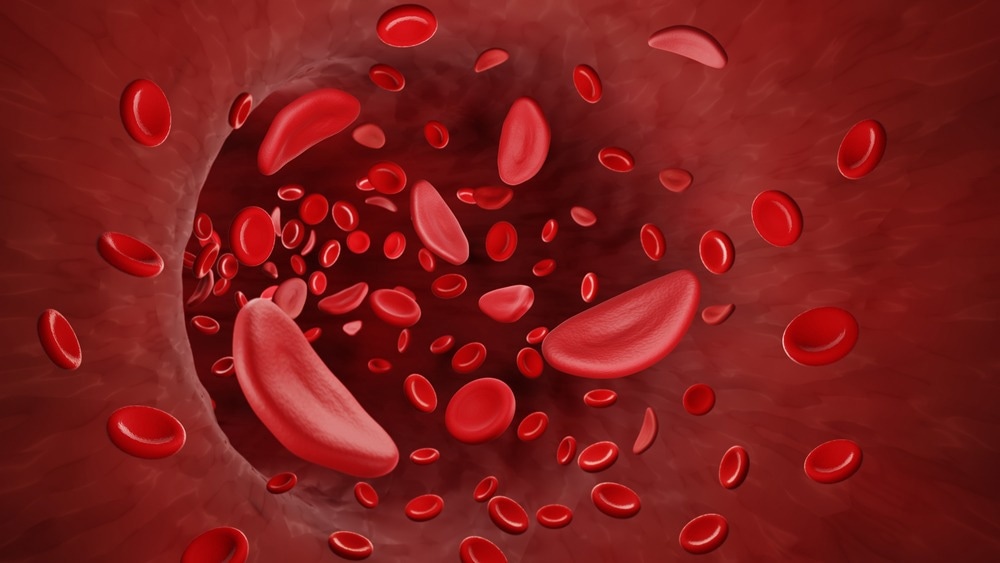Reviewed by Danielle Ellis, B.Sc.Apr 18 2023
At St Jude Children’s Research Hospital and the Broad Institute of MIT and Harvard, researchers have shown how prime editing could help correct the mutation that results in sickle cell disease in a possibly curative method.

(L to R) Mitchell Weiss, M.D., Ph.D., St. Jude Department of Hematology chair and co-corresponding author Jonathan Yen, Ph.D., St. Jude Therapeutic Genome Engineering director. Image Credit: St. Jude’s Children Hospital.
Sickle cell disease (SCD) is known to be a major blood disorder that impacts millions of people, mainly those of African descent. A mutation present in the gene that encodes a subunit of the oxygen-carrying molecule called hemoglobin causes the disease.
An accurate genome editing method called prime editing has been displayed by scientists at St Jude Children’s Research Hospital and the Broad Institute of MIT and Harvard. It has the potential to alter mutated hemoglobin genes back to their normal form in SCD patient cells, which helps in restoring normal blood parameters following the transplantation into mice.
The study outcomes were reported currently in the Nature Biomedical Engineering journal.

Image Credit: ART-ur/Shutterstock.com
To edit DNA, such as base editors and Cas9 nucleases, to treat genetic diseases, scientists have developed technologies quickly. The researchers of the study illustrated how a “third-generation” programmable gene editing technology known as prime editing could help transform the mutation that results in SCD into the normal DNA sequence, thereby saving the disease.
Prime editing is a promising approach because, in theory, we can directly correct disease mutations to specific healthy DNA sequences of our choosing. We optimized prime editing in long-term blood stem cells and showed that the prime editing cells maintain full engraftment efficiency in an animal with a clinically relevant system.”
Jonathan Yen, PhD, Study Corresponding Author, Department of Hematology, St Jude Children’s Hospital
“These results show efficient prime editing of blood stem cells and that the prime-edited cells maintain their full ability to engraft and repopulate the bone marrow of an animal,” stated senior and co-corresponding author David Liu, Ph.D., Richard Merkin, Professor at Broad Institute of MIT and Harvard, whose lab invented prime editing in 2019.
Liu added, “Bringing the ‘search-and-replace’ versatility of prime editing to blood stem cells raises the possibility of applying this technology to treat a wide range of diseases involving blood cells.”
Fixing the Mutation That Causes Sickle Cell Disease
The scientists displayed that the prime editing system can determine the disease-causing mutation in the adult hemoglobin gene with high specificity and substitute it effectively with the healthy DNA sequence variant that has been carried by the majority of humans.
Prime editing was successful in correcting this mutation that ranges up to 41% conversion in blood stem cells from SCD patients. Earlier research has displayed that editing more than 20% of cells probably translates to therapeutic benefit.
Adding to the therapeutic promise of the approach is the observation that when the scientists transplanted prime-edited cells from four SCD patients into mice, normal hemoglobin production was present in around 45% of circulating red blood cells, even ranging up to 17 weeks later.
Following the transplant, when positioned in low-oxygen environments, the red blood cells separated from the mouse bone marrow decreased sickling by half, from around 67% to 37%.
Improving Precision Gene Editing
We have identified what might be the next wave of therapies for genetic anemias. We took the newest cutting-edge genetic engineering technology and showed that we could make meaningful gene edits for future therapies.”
Mitchell Weiss, MD, PhD, Study Co-Author, Department of Hematology chair, St. Judes Children’s Research Hospital
While the researchers performed the study in SCD patient cells transplanted into mice, the method might have benefits over present genome-editing methods used in clinical trials, like Cas9 nucleases, which make double-stranded breaks in DNA that prime editing hugely prevents.
The collaborators had earlier displayed base editing, an alternative genome editing technology that could spin the sickle cell mutation into a benign variant, but not the actual healthy sequence, in a 2021 Nature publication.
The present study performed displayed prime editing could convert the disease mutation into the original normal gene variant via a T-to-A conversion, which base editing fails to make.
Even though the study exhibited the possible benefits of utilizing prime editing to cure genetic anemias, it also displayed limitations.
Prime editing needs a laborious process to adapt and improve every step of the protocol, like developing the prime editing guide RNAs (pegRNAs) that target the prime editing system to the correct DNA region and specify the preferred edit.
Safety First
Safety remains a worry for all genomic editing technologies, particularly novel methods. While the present study performed, comfortable with other laboratories’ reports on prime editing, displayed virtually no off-target prime editing, it could have unexpected safety problems as a newer gene editing technology.
“We are doing our best to predict toxicity, but we won’t know the true extent of the risks of this therapy until it is used in patients,” stated Weiss.
Even with such difficulties, the researchers are optimistic regarding the future of prime editing.
Because of its unique versatility, prime editing has the potential to cure many more genetic diseases. It will be a challenge to get to the clinic. It will require extensive manufacturing development, process optimization, and safety assessment. But the proof of concept is there. Our work now opens the door to developing cures for many hematological diseases.
Jonathan Yen, PhD, Study Corresponding Author, Department of Hematology, St Jude Children’s Research Hospital
The study’s first author is Kelcee Everette, a graduate student in Liu’s laboratory at the Broad Institute, who took part in the St. Jude Collaborative Research Consortium for Sickle Cell Disease to advance the work.
The other authors of the study are Rachel Levine, Kalin Mayberry, Yoonjeong Jang, Thiyagaraj Mayuranathan, Nikitha Nimmagadda, Erin Dempsey, Yichao Li, Senthil Bhoopalan and Yong Cheng, all of St. Jude; Gregory Newby, Jessie Davis, Andrew Nelson, Peter Chen and Alexander Sousa, Broad Institute; and Xiong Liu and John Tisdale, National Heart, Lung, and Blood Institute and the National Institute of Diabetes and Digestive and Kidney Diseases.
The study was financially supported by grants from the National Institutes of Health (U01 AI142756, RM1 HG009490, R35 GM118062, R01 HL156647, R01 HL136135, P01 HL053749, and P30 CA21765), the Bill and Melinda Gates Foundation, the Howard Hughes Medical Institute (Helen Hay Whitney Postdoctoral Fellowship), the St. Jude Collaborative Research Consortium for Sickle Cell Disease, the National Science Foundation GRFP fellowships and ALSAC, the fundraising and awareness organization of St. Jude.